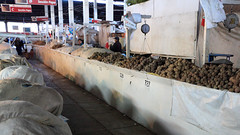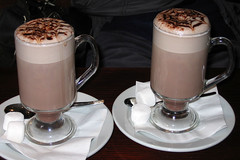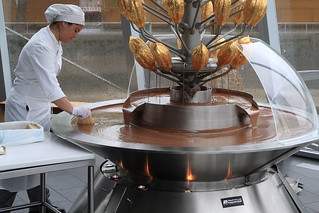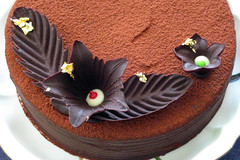

| Archive Blog Cast Forum RSS Books! Poll Results About Search Fan Art Podcast More Stuff Random |
|
Classic comic reruns every day
|
1 {photo of a cup of hot chocolate}
1 Caption: Drink of the Gods
|
First (1) | Previous (3267) | Next (3269) || Latest Rerun (2887) |
Latest New (5380) First 5 | Previous 5 | Next 5 | Latest 5 Annotations theme: First | Previous | Next | Latest || First 5 | Previous 5 | Next 5 | Latest 5 This strip's permanent URL: http://www.irregularwebcomic.net/3268.html
Annotations off: turn on
Annotations on: turn off
|
 One of the New World crops. There are still over 1000 types of potato grown in Peru. |
The first wave of explorers who crossed the Atlantic from Europe to the New World were motivated mostly by the desire to find resources that could form the basis of profitable trade. Gold and silver were the easy options - find these and you can simply lug them back home where they would be intrinsically valuable. But they were also on the lookout for plants and animals - new crops and livestock that people back home would find desirable. Some of the things they introduced to Europe from the Americas include potatoes, tomatoes, chilli peppers, peanuts, various beans, turkey, tobacco, corn (or maize, depending what flavour of English you speak), and pumpkin.
There was one crop in particular that grew in the tropical regions inhabited by the Aztec and Maya empires. They inherited this crop from the precursor Olmec civilisation. The Olmecs first began cultivating the trees around 3500 years ago, possibly bringing it north from an original range around the isthmus of Panama and the northernmost parts of South America. The Aztecs and the Maya used the seeds of the large bean-pods of the trees, drying them then grinding them into a powder which was then mixed with water and various spices to make a drink. They loved this bitter, spicy drink so much that they considered it a luxury item. The last Aztec Emperor, Moctezuma II, is said to have drunk nothing else.
 Modern version of the Aztec drink. |
When the Swedish naturalist Carl Linnaeus began classifying plants and animals in the biological system of nomenclature we use today, he assigned the tree that produced this drink the genus name Theobroma - from the Latin theo ("god") and broma ("food"). This plant was the "food of the gods". For the species name, Linnaeus took the sound of the tree's name in the Mayan language: kakaw. The tree's botanical name became Theobroma cacao. In English the tree was known as the cacao, or sometimes cocoa, tree. The drink the Aztecs made from the beans they called xocolatl, which was rendered into European tongues as chocolate.
And for many years after chocolate was introduced to Europe, is was only known as a drink. Someone, possibly Hernán Cortés himself, tweaked the Aztec recipe, switching out chilli and adding sugar, and the new sweet version became a big hit. At first the expensive imported beans were restricted to the Spanish nobility. As the import trade picked up, establishments dedicated to making and serving the beverage sprang up across Europe. By the 17th century, the drink had become fashionable and popular across the continent, with people enjoying its delicious and unique taste. In the late 17th century Hans Sloane, an Irish physician, decided to try mixing the drink with milk to make it more to his taste, producing something closer to the hot chocolate drink we know today. Further improvements came along in the 18th and 19th centuries as the commodity became cheaper and presses were invented to better extract the flavourful cocoa from the beans.
 Chocolate blocks. |
The last major breakthrough in chocolate came when Rodolphe Lindt[1] invented the process known as conching in 1879. In this process, chocolate is heated and mixed for several hours to change the chemical balance of the solids, fats, and volatile organic compounds in raw chocolate to produce a smoother, creamier texture and more pleasant flavour. Lindt's chocolate company has since gone on to become Lindt & Sprüngli, another major modern day chocolate maker.
And so we come back to those rainy Friday afternoons at school. I remember seeing just two different movies on those afternoons, each one multiple times through the years I was at that school. One was The Wizard of Oz. The other was Willy Wonka and the Chocolate Factory, which was my favourite of the two. The opening credits sequence always (and still to this day) lured me in with the visual feast of the inner workings of a chocolate factory. Delicious bars and sweets being coated in streams and rivers of luscious, molten chocolate. Little bite-sized pieces of pure joy. How could any kid resist the idea of visiting or working in a chocolate factory?[2] And then, halfway into the movie, there was the Chocolate Room. An enormous chamber decorated as a pleasant meadow, but in which everything—the rocks and all the plants, including the grass—were not only edible, but deliciously so. But this was blown away by the chocolate river. A literal river of chocolate, flowing through this landscape of dreams. And flowing into the river of chocolate, the chocolate waterfall. This was how Willy Wonka mixed and churned his chocolate - by waterfall. No other chocolate factory in the world mixes their chocolate by waterfall, as he explains in the movie. It's the only way.
 Chocolate being mixed at the Lindt Chocolate Museum, Cologne, Germany. |
You need to melt chocolate carefully, ensuring it doesn't overheat. A good way to do this is to use a double boiler, placing the chocolate in a pan over another pan full of almost boiling water. Which raises the other problem with melting chocolate. If you get so much as a drop of water into it, the molten chocolate will seize and turn into a stiff, lumpy mess like clay. So having your bowl of melting chocolate right next to a source of steam is just asking for trouble. Even worse, the chocolate can split if it's heated too much, or water gets in it, or you stir it too much, or you look at it wrong, or a dog outside barks at the moon. Splitting is the culinary term for when a mixture of fatty and non-fatty ingredients separates out. In the case of chocolate, the fatty cocoa butter can separate from the cocoa solids and other flavourings. The result is a yellowish pool of what is essentially oil, in which is sitting a disgusting brown lump of hard, grainy material. This is kind of the point of no return, and the best thing to do is discard the mess and start again. (Although some advice is that you can rescue the chocolate, in my experience this is difficult and unsatisfactory.)
Even if you melt the chocolate okay, then use it to make something like moulded chocolates or thin sheets of chocolate for decorating a cake or something, the solidified result can turn out poorly. This is because chocolate contains crystals of the fatty cocoa butter, which form as the chocolate cools from a molten to a solid state. Like other crystals, the size and distribution of the crystals is controlled by the conditions under which they form. For chocolate, this basically comes down to temperature. For good quality chocolate, you want small, even crystals. If you melt chocolate and cool it haphazardly, the crystals can grow unevenly and to large sizes. When this happens, the cocoa butter appears as white blotches on the surface of the chocolate, an appearance known as blooming. Blooming can also occur with old chocolate that has been stored at uncontrolled temperatures. Bloomed chocolate is still perfectly safe to eat, but looks terrible and has a weird texture. A more subtle problem is that the solidified chocolate can become plastic, in the sense of being easily bent, and have a dull surface texture. Chocolate is more appealing when it has a glossy sheen and also a certain amount of brittleness, that gives it a distinct snap when bent.
 Chocolate cake. |
Chocolate varies a lot in quality and taste, around the world and depending on how careful the manufacturers are and what particular ingredients they use. One thing I've noticed in particular is that non-Americans are uniformly critical of the quality and taste of American chocolate. I didn't really know why that was until I began researching this annotation. I found this description from the New York Times:
Everywhere but at home, American milk chocolate—specifically Hershey's—is known for its tangy or sour flavor, produced by the use of milk that [Alex] Landuyt [director of research and development for Barry Callebaut, one of the largest chocolate manufacturers in the world] refers to as "acidified." Although Hershey's process has never been made public (and a spokeswoman declined to comment on its techniques), experts speculate that Hershey's puts its milk through controlled lipolysis, a process by which the fatty acids in the milk begin to break down.This produces butyric acid, also found in Parmesan cheese and the spit-up of babies; other chocolate manufacturers [in the US] now simply add butyric acid to their milk chocolates. It has a distinctive tang that Americans have grown accustomed to and now expect in chocolate. "I can't think of any other reason why people would like it," said Whinney, of Theo Chocolate.
So, chocolate has become a worldwide phenomenon, recognised everywhere as a delightful comfort and luxury food. It has become one of the fundamental flavours of world cuisine, particularly for sweet foods. Almost anything sweet that comes in a choice of flavours offers chocolate as one of those flavours, and sometimes multiple different forms of chocolate, or chocolate mixed with other flavours to create an infinite range of blends. Chocolate is also used in some savoury dishes, particularly the delicious mole sauce of Mexican cuisine.
And so we return to Mexico, where Europeans first encountered the fruit of the cacao tree and the strange spicy drink the Aztecs made with it. The Conquistadors sought wealth. They found gold and silver, but they also found something that would come within the reach of the masses and bring delight to children and adults across the globe.
I'll leave with another direct quote, about the chocolate substitute known as carob, and long one of my favourite quotes concerning the irreplaceability of chocolate. This is from Sandra Boynton's book Chocolate: The Consuming Passion.
Carob is a brown powder made from the pulverized fruit of a Mediterranean evergreen. Some consider carob an adequate substitute for chocolate because it has some similar nutrients (calcium, phosphorus), and because it can, when combined with vegetable fat and sugar, be made to approximate the colour and consistency of chocolate. Of course, the same arguments can as persuasively be made in favour of dirt.
[2] In fact, I learnt from my wife that when doing her work experience requirement in high school, she chose to spend time working in a chocolate factory.
|
LEGO® is a registered trademark of the LEGO Group of companies,
which does not sponsor, authorise, or endorse this site. This material is presented in accordance with the LEGO® Fair Play Guidelines. |